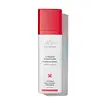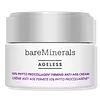What's inside
What's inside
 Key Ingredients
Key Ingredients

 Benefits
Benefits

 Concerns
Concerns

 Ingredients Side-by-side
Ingredients Side-by-side

Water
Skin ConditioningGlycerin
HumectantCoco-Caprylate
EmollientStearic Acid
CleansingCoconut Alkanes
EmollientGlyceryl Stearate
EmollientNiacinamide
SmoothingCaprylic/Capric Triglyceride
MaskingCetearyl Alcohol
EmollientPentylene Glycol
Skin ConditioningPassiflora Edulis Seed Oil
EmollientRetinol
Skin ConditioningSimmondsia Chinensis Seed Oil
EmollientSclerocarya Birrea Seed Oil
HumectantPrunus Armeniaca Kernel Oil
MaskingCetyl Ethylhexanoate
EmollientPalmitoyl Tripeptide-1
Skin ConditioningPalmitoyl Tetrapeptide-7
Skin ConditioningBrassica Oleracea Acephala Leaf Extract
HumectantBrassica Oleracea Italica Extract
AstringentTetrahexyldecyl Ascorbate
AntioxidantChrysin
Skin ConditioningPersea Gratissima Oil
Skin ConditioningLinoleic Acid
CleansingLinolenic Acid
CleansingCeramide NP
Skin ConditioningXanthophylls
Skin ConditioningPhytosphingosine
Skin ConditioningPhytosterols
Skin ConditioningJojoba Esters
EmollientPhysalis Pubescens Fruit Juice
Skin ConditioningStearyl Glycyrrhetinate
Skin ConditioningOryza Sativa Extract
AbsorbentGlycine Soja Oil
EmollientCarthamus Tinctorius Seed Oil
MaskingPalmitoyl Hexapeptide-12
Skin ConditioningCetyl Palmitate
EmollientTrehalose
HumectantLauric Acid
CleansingSodium Hyaluronate Crosspolymer
HumectantOlea Europaea Fruit Oil
MaskingGlucosamine Hcl
Tocopheryl Acetate
AntioxidantCoco-Caprylate/Caprate
EmollientPisum Sativum Extract
Skin ConditioningTocopherol
AntioxidantBambusa Vulgaris Leaf/Stem Extract
HumectantPhenoxyethanol
PreservativeCaprylyl Glycol
EmollientCarbomer
Emulsion StabilisingTrideceth-6 Phosphate
EmulsifyingN-Hydroxysuccinimide
Skin ConditioningCeteareth-20
CleansingSodium Hydroxide
BufferingLaureth-23
CleansingSteareth-20
CleansingPropanediol
SolventChlorhexidine Digluconate
AntimicrobialPolysorbate 20
EmulsifyingTrisodium Ethylenediamine Disuccinate
Chlorphenesin
AntimicrobialPotassium Sorbate
PreservativeEthylhexylglycerin
Skin ConditioningWater, Glycerin, Coco-Caprylate, Stearic Acid, Coconut Alkanes, Glyceryl Stearate, Niacinamide, Caprylic/Capric Triglyceride, Cetearyl Alcohol, Pentylene Glycol, Passiflora Edulis Seed Oil, Retinol, Simmondsia Chinensis Seed Oil, Sclerocarya Birrea Seed Oil, Prunus Armeniaca Kernel Oil, Cetyl Ethylhexanoate, Palmitoyl Tripeptide-1, Palmitoyl Tetrapeptide-7, Brassica Oleracea Acephala Leaf Extract, Brassica Oleracea Italica Extract, Tetrahexyldecyl Ascorbate, Chrysin, Persea Gratissima Oil, Linoleic Acid, Linolenic Acid, Ceramide NP, Xanthophylls, Phytosphingosine, Phytosterols, Jojoba Esters, Physalis Pubescens Fruit Juice, Stearyl Glycyrrhetinate, Oryza Sativa Extract, Glycine Soja Oil, Carthamus Tinctorius Seed Oil, Palmitoyl Hexapeptide-12, Cetyl Palmitate, Trehalose, Lauric Acid, Sodium Hyaluronate Crosspolymer, Olea Europaea Fruit Oil, Glucosamine Hcl, Tocopheryl Acetate, Coco-Caprylate/Caprate, Pisum Sativum Extract, Tocopherol, Bambusa Vulgaris Leaf/Stem Extract, Phenoxyethanol, Caprylyl Glycol, Carbomer, Trideceth-6 Phosphate, N-Hydroxysuccinimide, Ceteareth-20, Sodium Hydroxide, Laureth-23, Steareth-20, Propanediol, Chlorhexidine Digluconate, Polysorbate 20, Trisodium Ethylenediamine Disuccinate, Chlorphenesin, Potassium Sorbate, Ethylhexylglycerin
Water
Skin ConditioningTremella Fuciformis Polysaccharide
Emulsion StabilisingGlycerin
HumectantNannochloropsis Oculata Extract
HumectantSodium Acrylates Copolymer
Capryloyl Glycerin/Sebacic Acid Copolymer
Skin ConditioningGossypium Herbaceum Seed Oil
Skin ConditioningGlyceryl Stearate Se
EmulsifyingCoconut Alkanes
EmollientDiheptyl Succinate
EmollientSimmondsia Chinensis Seed Oil
EmollientCeramide NP
Skin ConditioningTocopheryl Acetate
AntioxidantChlorella Ferment
Skin ConditioningHibiscus Rosa-Sinensis Flower Extract
HumectantBidens Pilosa Extract
HumectantTremella Fuciformis Sporocarp Extract
Antioxidant1,2-Hexanediol
Skin ConditioningCoco-Caprylate/Caprate
EmollientBetaine
HumectantErgothioneine
AntioxidantIsohexadecane
EmollientSodium Acrylate/Sodium Acryloyldimethyl Taurate Copolymer
Emulsion StabilisingCaprylyl Glycol
EmollientEthylhexylglycerin
Skin ConditioningTrisodium Ethylenediamine Disuccinate
Tocopherol
AntioxidantLecithin
EmollientParfum
MaskingLinalool
PerfumingLimonene
PerfumingPotassium Sorbate
PreservativePhenoxyethanol
PreservativeWater, Tremella Fuciformis Polysaccharide, Glycerin, Nannochloropsis Oculata Extract, Sodium Acrylates Copolymer, Capryloyl Glycerin/Sebacic Acid Copolymer, Gossypium Herbaceum Seed Oil, Glyceryl Stearate Se, Coconut Alkanes, Diheptyl Succinate, Simmondsia Chinensis Seed Oil, Ceramide NP, Tocopheryl Acetate, Chlorella Ferment, Hibiscus Rosa-Sinensis Flower Extract, Bidens Pilosa Extract, Tremella Fuciformis Sporocarp Extract, 1,2-Hexanediol, Coco-Caprylate/Caprate, Betaine, Ergothioneine, Isohexadecane, Sodium Acrylate/Sodium Acryloyldimethyl Taurate Copolymer, Caprylyl Glycol, Ethylhexylglycerin, Trisodium Ethylenediamine Disuccinate, Tocopherol, Lecithin, Parfum, Linalool, Limonene, Potassium Sorbate, Phenoxyethanol
 Reviews
Reviews

Ingredients Explained
These ingredients are found in both products.
Ingredients higher up in an ingredient list are typically present in a larger amount.
Caprylyl Glycol is a humectant and emollient, meaning it attracts and preserves moisture.
It is a common ingredient in many products, especially those designed to hydrate skin. The primary benefits are retaining moisture, skin softening, and promoting a healthy skin barrier.
Though Caprylyl Glycol is an alcohol derived from fatty acids, it is not the kind that can dry out skin.
This ingredient is also used as a preservative to extend the life of products. It has slight antimicrobial properties.
Learn more about Caprylyl GlycolCeramide NP is a type of ceramide and formally known as ceramide 3.
Ceramides are intercellular lipids naturally found in our skin that bonds dead skin cells together to create a barrier. They are known for their ability to hold water and thus are a great ingredient for dry skin.
Ceramides are an important building block for our skin barrier. A stronger barrier helps the skin look more firm and hydrated. By bolstering the skin ceramides act as a barrier against irritating ingredients. This can help with inflammation as well.
If you would like to eat ceramides, sweet potatoes contain a small amount.
Read more about other common types of ceramides here:
Ceramide AP
Ceramide EOP
Coco-Caprylate/Caprate is created from fatty coconut alcohol, caprylic acid, and capric acid.
It is a lightweight emollient. Emollients create a thin barrier on the skin to trap moisture in. This helps keep your skin hydrated and soft.
Once applied, Coco-Caprylate/Caprate is absorbed quickly and leaves a silky feel.
Coco-Caprylate/Caprate may not be fungal acne safe.
Learn more about Coco-Caprylate/CaprateCoconut Alkanes is created from the fatty-acids of coconut oil. It is volatile, meaning it evaporates from the skin.
This ingredient is an emollient and solvent. As an emollient, it helps keep skin soft and hydrated. Solvents help distribute and mix other ingredients. This ensures a more even consistency.
Coconut Alkanes may not be fungal-acne safe.
Learn more about Coconut AlkanesEthylhexylglycerin (we can't pronounce this either) is commonly used as a preservative and skin softener. It is derived from glyceryl.
You might see Ethylhexylglycerin often paired with other preservatives such as phenoxyethanol. Ethylhexylglycerin has been found to increase the effectiveness of these other preservatives.
Glycerin is already naturally found in your skin. It helps moisturize and protect your skin.
A study from 2016 found glycerin to be more effective as a humectant than AHAs and hyaluronic acid.
As a humectant, it helps the skin stay hydrated by pulling moisture to your skin. The low molecular weight of glycerin allows it to pull moisture into the deeper layers of your skin.
Hydrated skin improves your skin barrier; Your skin barrier helps protect against irritants and bacteria.
Glycerin has also been found to have antimicrobial and antiviral properties. Due to these properties, glycerin is often used in wound and burn treatments.
In cosmetics, glycerin is usually derived from plants such as soybean or palm. However, it can also be sourced from animals, such as tallow or animal fat.
This ingredient is organic, colorless, odorless, and non-toxic.
Glycerin is the name for this ingredient in American English. British English uses Glycerol/Glycerine.
Learn more about GlycerinPhenoxyethanol is a preservative that has germicide, antimicrobial, and aromatic properties. Studies show that phenoxyethanol can prevent microbial growth. By itself, it has a scent that is similar to that of a rose.
It's often used in formulations along with Caprylyl Glycol to preserve the shelf life of products.
Potassium Sorbate is a preservative used to prevent yeast and mold in products. It is commonly found in both cosmetic and food products.
This ingredient comes from potassium salt derived from sorbic acid. Sorbic acid is a natural antibiotic and effective against fungus.
Both potassium sorbate and sorbic acid can be found in baked goods, cheeses, dried meats, dried fruit, ice cream, pickles, wine, yogurt, and more.
You'll often find this ingredient used with other preservatives.
Learn more about Potassium SorbateThis oil comes from the seeds of the desert shrub called Jojoba. It is more commonly known as jojoba oil, a non-comedogenic oil.
Jojoba oil does not contain fragrance and has many fatty-acids, making it a great soothing ingredient.
It also contains Vitamin E, a great moisturizing ingredient. Vitamin E is also an antioxidant and protects your skin against oxidative damage.
This ingredient humectant properties, meaning it helps draw moisture from the air. This helps keep your skin hydrated.
While jojoba has antibacterial properties, it is only able to kill some strains of bacteria.
Studies also show it helps in wound healing. In fact, Indigenous cultures have used jojoba as a moisturizer and to help treat burns for centuries.
Fun fact: Jojoba oil similar to natural human skin sebum, so it has a great effect on dry skin. It is also promising with helping to regulate sebum production.
Due to its fatty acid content, Jojoba oil may not be fungal acne safe. We recommend speaking with a professional if you have any concerns.
Learn more about Simmondsia Chinensis Seed OilTocopherol (also known as Vitamin E) is a common antioxidant used to help protect the skin from free-radicals and strengthen the skin barrier. It's also fat soluble - this means our skin is great at absorbing it.
Vitamin E also helps keep your natural skin lipids healthy. Your lipid skin barrier naturally consists of lipids, ceramides, and fatty acids. Vitamin E offers extra protection for your skin’s lipid barrier, keeping your skin healthy and nourished.
Another benefit is a bit of UV protection. Vitamin E helps reduce the damage caused by UVB rays. (It should not replace your sunscreen). Combining it with Vitamin C can decrease sunburned cells and hyperpigmentation after UV exposure.
You might have noticed Vitamin E + C often paired together. This is because it is great at stabilizing Vitamin C. Using the two together helps increase the effectiveness of both ingredients.
There are often claims that Vitamin E can reduce/prevent scarring, but these claims haven't been confirmed by scientific research.
Learn more about TocopherolTocopheryl Acetate is AKA Vitamin E. It is an antioxidant and protects your skin from free radicals. Free radicals damage the skin by breaking down collagen.
One study found using Tocopheryl Acetate with Vitamin C decreased the number of sunburned cells.
Tocopheryl Acetate is commonly found in both skincare and dietary supplements.
Learn more about Tocopheryl AcetateTrisodium Ethylenediamine Disuccinate is used to help stabilize a product.
It is a chelating agent, meaning it helps prevent metal ions from binding to other ingredients. This prevents unwanted reactions in products. Metal ions can come into a product via the water ingredient. They are found in trace amounts and are not known to be harmful.
Water. It's the most common cosmetic ingredient of all. You'll usually see it at the top of ingredient lists, meaning that it makes up the largest part of the product.
So why is it so popular? Water most often acts as a solvent - this means that it helps dissolve other ingredients into the formulation.
You'll also recognize water as that liquid we all need to stay alive. If you see this, drink a glass of water. Stay hydrated!
Learn more about Water